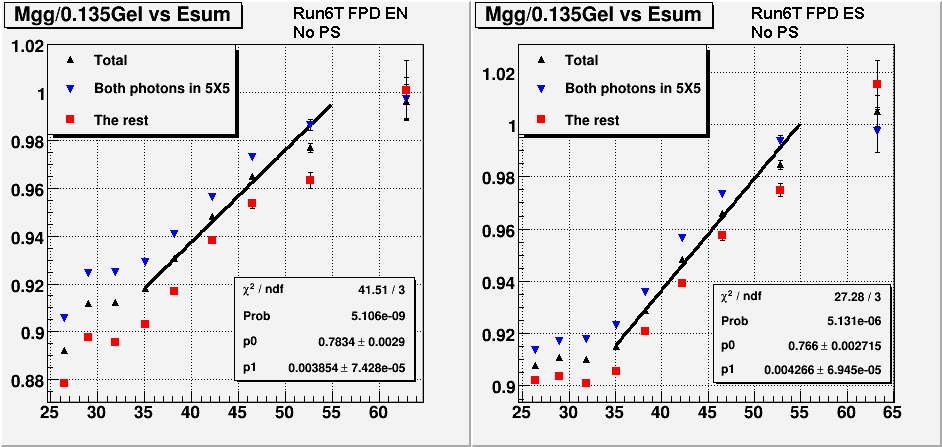- leun's home page
- Posts
- 2013
- 2012
- December (2)
- October (3)
- September (2)
- August (1)
- July (4)
- June (4)
- May (2)
- April (3)
- March (5)
- February (5)
- January (5)
- 2011
- December (3)
- November (3)
- September (5)
- August (2)
- July (2)
- June (3)
- May (4)
- April (4)
- March (2)
- February (4)
- January (2)
- 2010
- December (2)
- November (3)
- October (3)
- September (5)
- August (6)
- July (2)
- June (4)
- May (3)
- April (4)
- March (4)
- February (2)
- January (4)
- 2009
- 2008
- October (1)
- My blog
- Post new blog entry
- All blogs
Run6 Transverse Data Energy Dependent Mass Shift Analysis
Here we take a look at the run6 transverse DATA, to better understand the energy dependent gain correction.
1. FPD at middle position (Xoffset~30.7cm)
2. Fiducial volume cut: Both photons in 6X6
3. Energy sharing (Zgg) < 0.7
4. BBC minimum bias condition
5. Vertex=0
6. NO PRESHOWER ENERGY INCLUDED
The last two points will be addressed very shortly. The lack of preshower energy makes it especially difficult to directly compare the results to the previous, "official" analysis results, but I think it's also interesting to see what happens if you have unaccounted upstream energy loss. The preshower detector, as I understand it, is vertical columns of the same Pb glass cells, so it should be ~1.5 radiation lengh.
First we look at the difference between "Inner" events, where both photons were found in the central 5X5, to all other events that pass the above cuts. (Including the fiducial cut) The fit results for the total event set are attached at the bottom of the page.
Energy dependence of invariant mass, "Inner" vs. the rest
The first thing to notice is that the magnitude of the slope (~4%/10GeV) is much greater for all cases than we are used to. Previous analysis by Larisa saw less than 1%/10GeV for the same data set. I think this is very likely due to the lack of preshower energy, but it is also true that the analysis code used here are quite different from the Fortran code. The reconstruction should still be mostly the same, but we don't know that for sure yet.
There is also clearly a different regime below 35GeV. That is nominally below threshold, and it isn't clear yet what is going on there.
In any case, we see that the difference between inner and non-inner is in the offset, but not so much in the slope. We see more interesting differences in the following comparison.
Now we look at the same energy dependence as a function of the decay angle. There are three cases, vertical (+-0.4 radians), horizontal (+-0.4 radians), and diagonal (the rest).
Above threshold, we see little evidence of horizontal preference over vertical. The only point that significantly distinguishes the two are ~53GeV on the south. On the other hand, diagonal decays show much milder slope than the vertical and horizontal decays. This is more consistent with the projective geometry simulation, but only qualitatively. ("Normal" geometry for the simulation so far has been at "far", ~65% further away from the beam) It is not clear why it differs so much from the simulations that also do not include preshower energy.
- leun's blog
- Login or register to post comments


